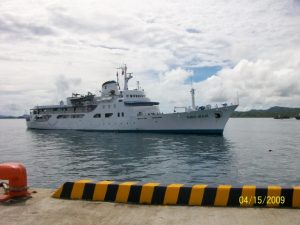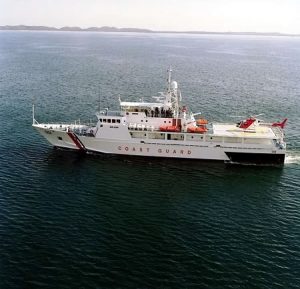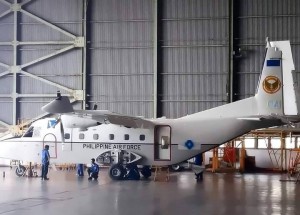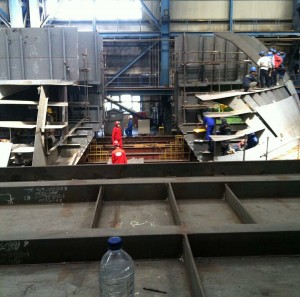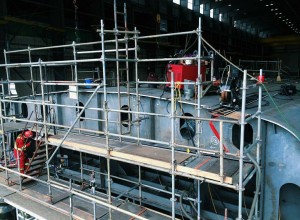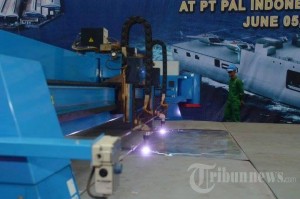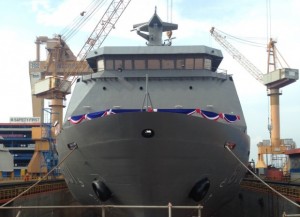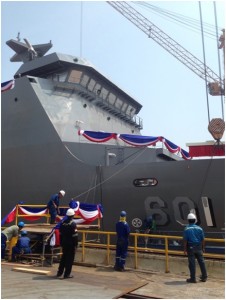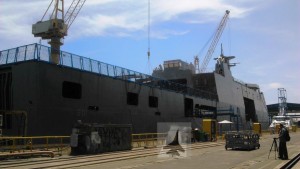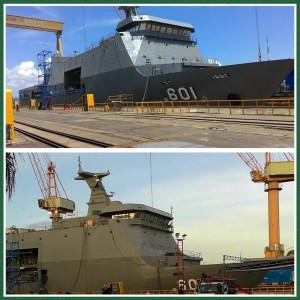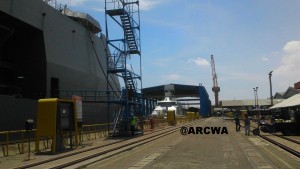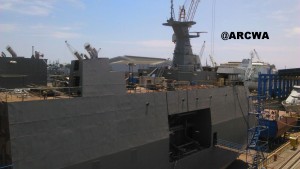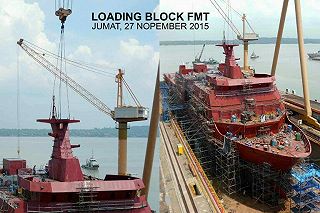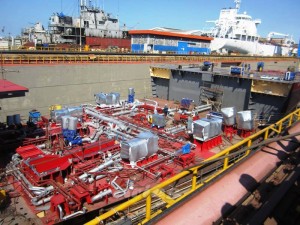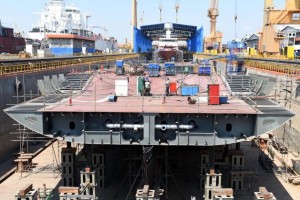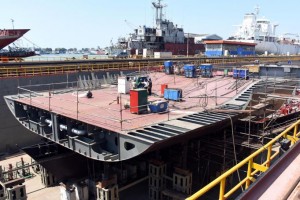
Philippine Defense Today (Adroth.ph)
In Defense of the Republic of the PhilippinesThe Philippine Navy’s third Del Pilar Class frigate, the former USCG Cutter Boutwell, is now at Coast Guard Island in Northern California. Originally turned over to the Philippine Navy at its final duty station in San Diego, CA in April of this year, the ship got underway in the evening of June the first, traveled along the California coast, and arrived USCG Base Alameda following day.
The last occasion a PN vessel was at Coast Guard island was in 2011, when BRP Gregorio del Pilar, the first WHEC, was turned over and then stationed at this USCG for the duration of the Filipino crew’s training program.
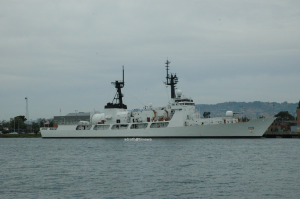 |
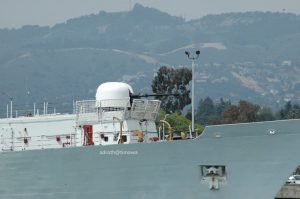 |
|
| Full aspect view | The sixth Oto Melara 76mm gun in the fleet | |
 |
 |
|
| Mizen mast | Main mast |
Why not turn over the BRP Ang Pangulo to the Philippine Coast Guard?
Tuesday , 17, May 2016 BRP Ang Pangulo (AT-25), Philippine Navy Leave a commentPresident-elect Duterte announced in a press conference that he intended to put up the Presidential Yacht, Ang Pangulo (AT-25), for sale. The following is an excerpt from a GMA news report.
DAVAO CITY — Presumptive president Rodrigo Duterte on Sunday said he will put presidential yacht, the BRP Ang Pangulo, up for sale to the highest bidder.
Duterte said this in an interview with reporters at Hotel Elena after meeting with prospective chiefs of the Philippine National Police and Armed Forces of the Philippines.
Both President Estrada and President Aquino made similar statements prior to being sworn into office, and for good reason. A “Presidential Yacht” smacks of government excess. A luxury item that a poor country could ill-afford.
But is a yacht really all it can be?
Given how long it takes government to acquire assets through its byzantine procurement process, prudence demands continual exploration of other options for a historical asset that is already in the government’s possession. Additional hulls, especially new-build ones, could very well take years to obtain. The AT-25 is already there!!!
Suitability of the ship for Coast Guard duties will depend on its internal configuration, the material condition of the ship, as well as its hydrodynamic and sea-keeping performance. However, barring any major issues in these areas of consideration, the following facets of the AT-25’s design holds interesting potential for the PCG.
Size matters
A common engagement tactic among protagonists in EEZ conflicts — from the Cod War of the 60’s between Iceland and the UK, and in the West Philippine Sea today — is ramming. The following video below shows one such between the Chinese and Vietnamese Coast Guard shows how such an engagement can occur. With a displacement of 2,239 tons, the AT-25 — theoretically — has sufficient mass to engage in such encounters with all but the largest Chinese Coast Guard vessels.
Unparalleled range
The current largest PCG vessels, the 56-meter Tenix Search and Rescue Vessels, have a range of 2,000 miles at 15 knots. In contrast, the AT-25 has a range of 6,900 miles travelling at identical speed. This makes the AT-25 an interesting platform for long-endurance patrols, or for conducting extended surveillance on Chinese vessels that are anchored within our EEZ.
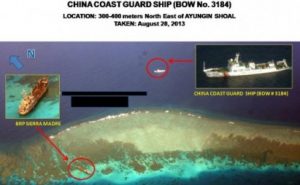 |
| Photo from Interaskyon.com. Chinese Coast Guard vessel anchored off Ayungin shoal |
Mobile Coast Guard station
Given its current role as a command and control vessel, which will be taken over by the Tarlac class SSVs, the AT-25 is also well suited to function as a mobile Coast Guard Station. One that can be moved at will, anchored at a troublespot, and have the endurance to stay on station far longer than any existing PCG or BFAR vessels — all without taking purpose-built SAR vessels away from their normal duties.
Improve its sensor-suite and it could theoretically perform, at the very least, as a Vessel Traffic Management System platform, or a most a radar picket vessel.
The US implemented a similar concept in the Persian Gulf with its Afloat forward staging base-interim concept. The American solution, which is based on the retired LPD USS Ponce, however is at a much grander scale. As shown in the previous section, the Chinese Coast Guard is also performing this function in Ayungin. If the Ayungin station becomes uninhabitable, and a replacement facility remains elusive, AT-25 could theoretically take its place.
RHIB carrier
Coupled with the range advantage described above, the AT-25 is also a potential Rigid Hull Inflatable Boat (RHIB) carrier. RHIBs are essential for conducting Visit, Board, Search, and Siezure (VBSS) operations which are integral to the PCG’s Maritime Law Enforcement (MARLEN) mission. The ship has existing davits for the embarkation of motor launches. These davits, however, could theoretically either be modified, or replaced entirely, to launch RHIBs in the same manner as the Del Pilar Class frigates.
 |
 |
|
| Motor launch on AT-25 | RHIB on Del Pilar Class frigate. Photo taken while PF-15 was still in Alameda, CA |
Tale of the stats
To get the ball rolling on discussions in this direction, the following is a comparison between it and the largest rescue vessel in the PCG inventory: the 56-meter Tenix Search and Rescue Vessel.
Inventory: Lockheed-Martin C-130 / L-100-20 (Updated)
Sunday , 8, May 2016 C-130, Philippine Air Force Leave a commentThe following is a record of Lockheed C-130 Hercules and L-100-20 (civilian version of the C-130) aircraft that are currently in the Philippine Air Force. Most are inactive at the C-130 graveyard in Mactan, Cebu. A small — but growing — fraction are operational. As per Manokski’s C-130 page, a total of 19 C-130s had entered PAF service since 1973. This inventory, however, only represents the aircraft that were in the PAF’s possession (active or otherwise) at the turn of the century.
The basic structure of the data below is derived from an exhaustive list of C-130s from around the world prepared by Bob Daley in 01 May 2006 (see here). This format has been expanded to suit this site’s purposes. This article has been updated to reflect the arrival of an additional C-130T in 2016.
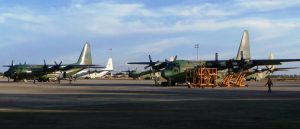 |
| Photo c/o Francis Neri albums |
Photographs in the photo album were complied for the following Facebook page: Philippine Defense Today. These now link to albums on this page as the original Timawa FB extension for C-130s is now unmanaged.
| # | Original registration | Original model | Final model | Current # | Photo album | Note |
| 3520 | 58-0725 | C-130B | 0725 | See here | Previously assigned to the USAF 53rd WRS. Sold to the PAF in 1995, retired in 1997. Scrapped. Ref | |
| 3535 | 58-0738 | C-130B | 0738 | See here | Previously assigned to USAF Reserve 731st Tactical Airlift Squadron. Ref | |
| 3545 | 58-0747 | C-130B | 3545 | See here | Previously assigned to the USAF 54th WRS in Guam. Ref Transferred to AMARC in 29APR 1992. (AACF0107) Transferred to the PAF in 09 Oct 1997. Inactive and previously left to exposed to the elements at the C-130 graveyard in Mactan AFB. Sighted in 2016 sporting a new paint scheme but still non-operational. Ref |
|
| 3547 | 58-0749 | C-130B | 0749 | See here | Previously assigned to the Ohio National Guard and USAF Reserve | |
| 3552 | 58-0753 | C-130B | 3552 | See here | Transferred to AMARC in 19 Aug 1992 (AACF0112). Transferred to PAF in 29 Sep 1997 Ref | |
| 3593 | 60-0294 | C-130B | 0294 | See here | Previously assigned to the USAF Reserve | |
| 3633 | 61-0954 | C-130B | 3633 | See here | Active. Underwent its Programmed Depot Maintenance at the 410th Maintenance Wing in Clark AFB. It re-entered service on December 28, 2012 | |
| 3646 | 61-0961 | C-130B | 0961 | See here | ||
| 3946 | N1130E | L100 | L100-20 | 3946 | See here | Civilian version of the military C-130. This was the original Lockheed demonstrator for the L100 |
| 4512 | N7967S | L100-20 | 4512 | See here | Civilian version of the military C-130 | |
| 4593 | RP-C101 | L100-20 | 4593 | See here | Acquired in 1983, and started Programmed Depot Maintenance (PDM) at the Clark Economic Zone done by Asian Aerospace Corporation in February 2004. Crashed into Davao Gulf 25 August 2008 | |
| 4704 | C-130H | 4704 | See here | Active. Returned from a Programmed Depot Maintenance cycle in the United States on October 2012 | ||
| 4726 | C-130H | 4726 | See here | Active. Subjected to PDM at Clark Field by Lockheed Martin / Asian Aerospace. Maintenance cycle completed in June 2009. Ref | ||
| 5011 | C-130T | 5011 | See here | Active. The sale of two Ex-USMC C-130T aircraft was approved on July 24, 2014. The first unit was delivered on April 12, 2016. Ref |
Transfer of ex-South Korean Pohang class corvette underway
Monday , 4, January 2016 Philippine Navy Leave a commentNothing confirms the impending transfer or an EDA asset like a PhilGEPS invitation seeking bidders for contracts to refurbish the acquisition target. The long reported, and mysterious, Pohang class corvette from South Korea has not only been confirmed in this manner, it has also been identified. See the relevant PhilGEPS invite below:
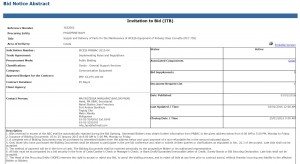 |
Rumors of a potential Pohang class transfer first surfaced in 2011. However a formal announcement of the transfer was not made till 2014. Both events were discussed on the Timawa forum on this thread.
The ROKS Mokpo (PCC-759) was the fourth ship in the Pohang Class to be built. Produced by Daewoo SB & Hvy Mach., Okpo in 1988. It is the last of the class to be optimized for Anti-Surface Warfare (ASuW) and armed with Exocet Surface-to-Surface Missiles (SSM). Subsequent members of the class geared towards for Anti-Submarine Warfare (ASW) missions.
In Korean service, it was armed with 2 MM38 Exocet launchers, a single 76mm Oto Melara DP gun, 2 twin Emerlec AA guns, and 2 triple 324mm ASW torpedo tubes. Its air search capability stemmed from a Raytheon SPS-64 radar, and for ASW functionality, it was equipped with a Thales PHS-32 hull mounted sonar. As of writing it is unclear how much of this equipment would be retained in the transfer.
Unlike the Hamilton class WHECs whose gas turbines were of an older variant that were used exclusively by the class, the Pohang is powered by the significantly more commercially successful General Electric LM-2500 which is the gold standard for marine gas turbines. For low-consumption transit, the Mokpo relies on its two MTU 12V956 diesel engines.
 |
| Photo c/o itiexue.net |
References
Combat Fleets of the World, 15th Edition
2015: What’s happening with the AFP modernization program
Thursday , 24, December 2015 AFP modernization Leave a commentWhereas 2014 was the year of the “Notice of Award”, 2015 was the year of deliveries. No less than 18 projects — for all three services — saw their first or full deliveries this year, making it the most active project-conclusion period since the first acquisitions of the AFP Modernization Program in 2003.
Among the capabilities that the AFP acquired this year are:
- Supersonic flight with a limited capability for conducting air interception missions
- Close air support platforms that can engage ground targets at night
- Significant increase in cargo transport capability, both by air and sea
- Armored, night-fighting-capable, mobility for mechanized troops
 |
 |
|
| Commissioning ceremony for various PAF assets. Photo c/o DND | Armored recovery vehicles during the 80th anniversary of the Armed Forces of the Philippines. Photo c/o DND |
To give a more complete view of the state of the modernization program, this year’s article is divided into the following sections, presented here in reverse order:
- Pending acquisitions – these are acquisitions that have been publicly announced, either in conventional media or on the DND Website, that are still in various stages of completion. Some are still awaiting results of bids or re-bids. Others have had Notices to Proceed (NTP) to issued. Notable examples of projects in this state are the Philippine Army Shore-based Missile System and the Philippine Navy Frigate projects. Both of which have experienced very public reversals over the past year.
- Awaiting delivery – these are are projects for which the acquisitions are in the process of being built from scratch, or are currently undergoing mandatory refurbishment, and have yet to be formally turned over to the AFP for operational use. A notable examples of acquisitions in this state would be the Strategic Sealift Vessel which is currently underconstruction in Indonesia and the ex-ROKN Mulkae class LCU, which is already in the Philippines, but is still awaiting refurbishment before it can be commissioned into service.
- Acquisition list – these are items that are officially in the possession of the Armed Forces of the Philippines.
In addition to the various official acquisitions, South Korea has committed to providing the Philippines with one surplus Pohang Class corvette (see here). To this date, details of this project have not been firmed up. It is unclear if this project will materialize.
Note: This article is also available on the Timawa.net forum on the long standing What’s happening with the AFP modernization thread that’s been documenting the progress of the up-arming effort since 2003.
The acquisition list
The following list focuses on actual deliveries of equipment that were made in 2015.
 |
Surface Attack Aircraft / Lead-In Fighter Trainer |  |
After an arduous 5-year process — from concept to signing — the Philippine Air Force is finally slated to return to supersonic flight operations after almost a decade with the acquisition of twelve (12) Korean Aerospace Industries FA-50PH Fighting Eagle aircraft worth P18.9B. These will also be the first brand new supersonic aircraft that the PAF will acquire since the factory-fresh F-5A Freedom Fighters that were delivered in the 60s. Subsequent fighter acquisitions had focused on excess defense articles such as the F-8 Crusaders which were recovered from AMARC and 2nd-hand F-5As from South Korea. The first two aircraft were delivered to Clark Air Base on November 28, 2015 with the first aircraft touching down at 10:23AM GMT+8. Details here.
The screen capture on the right was taken from the official PAF video timeline of the event. |
| Attack Helicopter Acquisition Project |  |
The DND awarded the contract to supply eight Agustawestland AW109E helicopters in late 2013. Training of flight and maintenance crews commenced in Italy in 2014. The first two units were delivered in late December 2014 along with two Philippine Navy Multi-purpose AW109s. The remaining six were delivered this year and commissioned on the 5th of December. Details here. | |
| Combat Utility Helicopter (CUH) |
 |
Not to be confused with the Arroyo-era CUH project that acquired the W-3 Sokol in 2009, this P4.8B project sought to acquire eight additional helicopters for combat and VIP duties. This project went to Bell Helicopter which will delivered Bell 412EP aircraft by 2015. Three of these helicopters will be delivered in VIP transport configuration. See here. | |
| Refurbished UH-1 acquisition project |
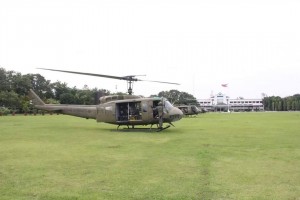 |
This P1.26B project sought to acquire 21 refurbished UH-1 Iroqouis helicopters. The helicopters eventually bought were ex-German “D” versions, built under license in Germany aircraft that were equivalent to the “H” versions that were already in service with the PAF. This effort was marred by scandal with allegations of extortion, resulting — intially — in the cancellation of the deal while deliveries were being made, and then made even more controversial by the DND’s self-exoneration of all charges without the benefit of a third-party investigation. Details of this convoluted affair are available here. | |
| Medium-Lift Aircraft acquisition project | 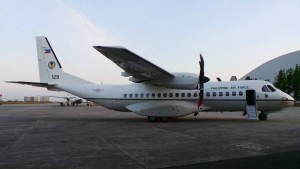 |
Notice of award for this P5.3B acquisition was issued to Airbus for the delivery of three C-295 aircraft on February 2014. The first aircraft was delivered on March 30, 2015, while the second aircraft arrived on September 15, 2015, and the third arrived on December 11, 2015. Details here. | |
| Rockwell OV-10 Bronco refurbishment | 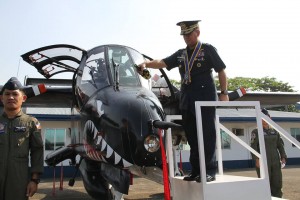 |
OV-10 #636 returned to service in November 2015. This was part of a PhP16,490,363.56 effort to return two OV-10s to active duty. #402 is also slated for refurbishment See here. | |
 |
BRP Ivatan (AT-298) |
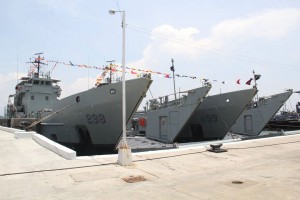 |
On the 2nd of July 2015, Philippine Navy personnel arrived in Australia to take possession of two Balikpapan Class Landing Craft Heavy (LCH): HMAS Brunei and HMAS Tarakan. They were donated by the Australian government as part of an aid package promised in the wake of Typhoon Haiyan. Both ships were commissioned into the Royal Australian Navy in 1973 and were subject to navigational upgrades before being turned over to the Philippines.
The former HMAS Brunei entered service with the Philippine Navy as the BRP Ivatan on July the 23rd, 2015. See Timawa discussion here. |
| BRP Batak (AT-299) |
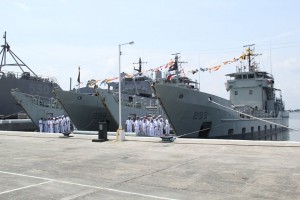 |
The former HMAS Tarakan entered service with the Philippine Navy as the BRP Ivatan on July the 23rd, 2015 and was donated by the Australian government along with the HMAS Brunei as described above. See Timawa discussion here. | |
| BRP Lake Caliraya (AF-81) | 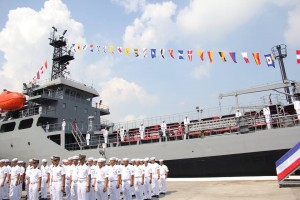 |
The first of three tankers that the Philippine Navy received from the Philippine National Oil Corporation (PNOC) was commissioned into service on the 23rd of May 2015 as the BRP Lake Caliraya . Timawa discussion here. | |
| Agustawestland AW-109E gunships |
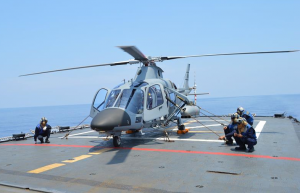 |
Two armed AW-109E gunships were commissioned into Philippine Navy service on August 10, 2015. These joined the three AW-109s that were delivered in December 2014. These aircraft featured combination 0.50 cal gun and 2.75 inch rocket pods comparable to those carried by PAF AW-109s.
The photo on the left shows one of these gunships on a deck qualification landing on the BRP Gregorio del Pilar. Photo c/o of the Philippine Navy. |
|
| Britten Norman Islander refurbishment |
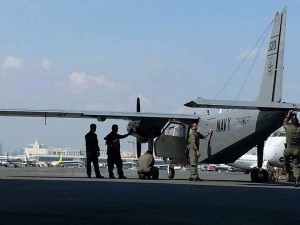 |
The Philippine Aerospace Development Corporation (PADC) delivered a refurbished Philippine Navy BN Islander (#PN320) on July 21, 2015 sporting a new grey color scheme. See Timawa discussion here. | |
| PF-16 weapons upgrade | 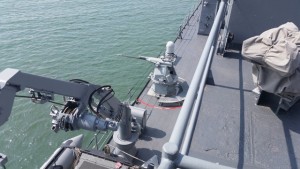 |
The two Mk.38 25mm RCWS were initially slated for installation prior to the ship’s departure from South Carolina but had been delayed. Timawa discussion here. | |
| General Purpose Machine gun 7.62mm |  |
On January 4, 2015, the Philippine Marines received 220 units of US Ordnance M-60E6 General Purpose Machine Guns via FMS. See Timawa discussion here. Photo c/o Philippine Star. | |
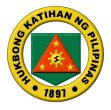 |
ex-Belgian Army M113 Armored Personnel Carriers with RCWS |
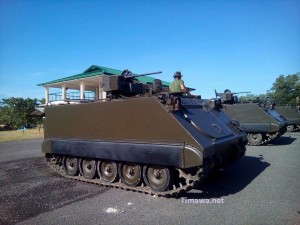 |
The first six of 28 ex-Belgian Army M113s from Israel were delivered on July the 28th. These units were armed with Elbit Remote Control Weapon Systems (RCWS) which featured .50 cal machine guns in a gyro-stablized mounts. In an interview with the PNA, Army spokesperson Lt. Col. Noel Detoyato reported that fourteen of the remaining M-113s were configured as fire support vehicles, four as infantry fighting vehicles, and another four as armored recovery units. See Timawa discussion here. |
| ex-US Army M113A2 Armored Personnel Carriers |
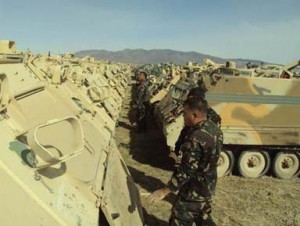 |
The Philippine Army acquired 114 M113A2 armored vehicles, in various configurations, from the US as Excess Defense Articles (EDA) (Timawa discussion here). While the transfer of the vehicles were completed as early as January 2014, difficulties in arranging for transport delayed actual delivery, which eventually cost the GRP P67.5M. The first 77 units were delivered to Subic on December 9, 2015 | |
| High Mobility Multipurpose Wheeled Vehicle – Ambulance variant | 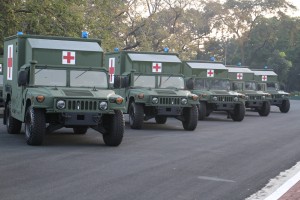 |
Thirty units of HMMWV ambulances with associated shelter and medical equipment acquired. Twenty-three were delivered on January 26, while the remainder arrived the following month. Total value for this acquisition was 229,944,149.10. Details here. | |
 |
Chemical, Biological, Radiological, and Nuclear protective and detection gear |
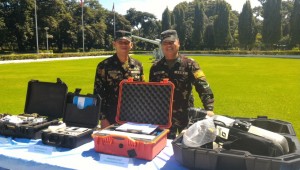 |
The Armed Forces of the Philippines (AFP) received $1 million worth of chemical, biological, radiological and nuclear (CBRN) protective gear and detection equipment from the United States intended for the Army Support Command on Thursday at Camp Aguinaldo. According to the US Embassy press release about the donation:
The Dismounted Reconnaissance Sets Kits and Outfits (DRSKO) is a portable collection of Chemical, Biological, Radiological and Nuclear (CBRN) protective gear and detection equipment used to support dismounted Reconnaissance, Surveillance and CBRN site assessment missions. This increases the AFP’s capabilities to conduct CBRN site assessments to mitigate risks and gather intelligence on Chemical Agents, Biological Agents or other potential chemical hazards. The DRSKO is designed to equip a team of 27 CBRN personnel. The photo shown on the right was taken from the above-mentioned embassy press release. See Timawa discussion here. |
 |
GA Special Purpose Rifle (SPR) / Designated Marksman Rifle (DMR) | 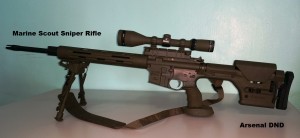 |
Government Arsenal produced 70 units of these SPR/DMR for the Philippine Marine Corps and Philippine Army. For the Marines, this involved upgrading existing Marine Scout Sniper Rifles (MSSR) from their Generation-3 configuration to this, which could be called “Gen 4”. For the Philippine Army, particularly the Scout Ranger Regiment, the GA upgraded unused lower-rifle components for M-16A1s that were previously in LOGCOM storage. See Timawa discussion here. |
| GA 5.56 16 inch mid-length barrel |
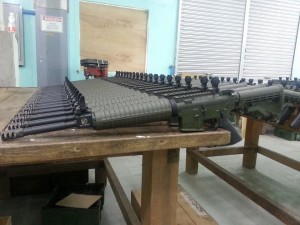 |
The Government Arsenal undertook refurbishment of 400 existing M-16A1 rifles to their GA Carbine 16 inch mid-length standard. First units were issued to JSOG and NAVSOG. See Timawa discussion here. |
In addition to acquisitions via bidding, South Korea has committed to providing the Philippines with one surplus Pohang Class corvette, a landing craft, and several rubber boats. These and the aforementioned Korean acquisitions have yet to be delivered and have therefore been omitted from the list above.
Awaiting delivery
A significant number of high-profile projects remain pending, and have been omitted from the acquisition list. These are listed immediately below.
| Service | Ongoing projects | |||||||
 |
|
|||||||
 |
ex-ROKN Mulkae class (LCU-78) – South Korea promised this EDA item in June 2014 and quietly delivered the boat in July 2015. As of writing the ship remain queued for a refit costing P27,138,295.51, and has not yet been commissioned into PN service. See Timawa discussion here. LCH 3, 4, and 5 – efforts are underway to acquire three more Balikpapan class Landing Craft Heavies from Australia. Invitiations to bid have even been issued for equipment associated with these vessels. See here. Amphibious Assault Vehicle (AAV) – Samsung Techwin was declared the lowest single calculated bidder for the P2.5B AAV project. Details here.
|
|||||||
 |
5.56mm assault rifle acquisition – this project went to Remington to supply rifles to both the Philippine Army and Philippine Marines in 2013 with deliveries made in 2014. However, issues with rifle quality hounded the acquisition which in faced termination earlier this year. The AFP announced that by August, Remington had replaced all defective rear-sights and that they were satisfied with them. It was unclear whether or not other quality related issues (e.g., quality of hand guards, rumored Front Sight Block alignment issues, etc.) were also resolved. Another batch of rifles is due for delivery. Rocket Launcher Light Acquisition Project – Airtronic USA, Inc. was selected to supply 400 US-made RPG7 rocket launchers, and associated 40mm rockets, as part of a Foreign Military Sale (FMS) deal. While components of this deal have reportedly been delivered, the remainder remain obscure. For that reason, this project remains listed as “awaiting arrival. See Timawa discussion here. |
|||||||
 |
|
Pending acquisitions
A significant number of high-profile projects remain pending, and have been omitted from the acquisition list at the bottom of this article. These are listed immediately below.
| Service | Pending projects | |
 |
Long Range Patrol Aircraft acquisition project – the DND declared a bidding failure in August due to documentation deficiencies among bid participants. see here.
Close Air Support Aircraft acquisition project – the bid for this project failed for the second time in December 2015. Based on procurement rules, the DND is now authorized to pursue negotiated procurement. However, an announcement to that effect has yet to be issued. See here. Air defense radar acquisition project – like the SAA/LIFT project, this P2.68B acquisition is part of the PAF’s systems approach to reviving the country’s ability to enforce the Philippine Air Defense Identification Zone (PADIZ). This project has been the subject of much speculation, with very little official discussion. The TPS-77 and Elta ELM 2288 are touted as contenders for this project, however media reports have touted the Israeli contender as being favored. See details here. SAA/LIFT munitions – the ordnance that SAA-LIFT aircraft will carry are being acquired via a separate acquisition project. These include Air-to-Air Missiles (312 Pieces), Air-to-Surface Missiles (125 Pieces), 20mm ammo (93,600 Pieces), and Chaffs/IR Flares. Details here. Upon arrival of the first two FA-50s, however, the PAF revealed that this project had fallen behind and would not yield results till three years. |
|
 |
Frigate Acquisition Program – this P18B project seeks to acquire two brand new multi-role frigates in a complicated two-stage bidding process. To date, the following shipbuilders have signified interest in the project: Navantia Sepi (RTR Ventures), STX Offshore & Shipbuilding, Daewoo Shipbuilding & Marine Engineering Co Ltd, Hyundai Heavy Industries Inc., Garden Reach Shipbuilders & Engineers Ltd of India, STX France SA. Details here.
Anti-Submarine Helicopter Acquisition – as of writing, Agustawestland was the only company that qualified to take part in the bidding in November. Second-stage bidding set for December 22, 2015. See here. USCGC Boutwell (WHEC-719) – On November 17, 2015, the Office of the President of the United States issued a press statement that confirmed a planned transfer of the USCGC Boutwell to the Philippines as an Excess Defense Article item. This confirmed various US news reports circulating the month before of the impending transfer. Incidentally, the first crew of the BRP Gregorio del Pilar, previously the USCGC Hamilton, served on board the Boutwell as part of their training for accepting the PN’s first Hamilton class WHEC. See Timawa discussion here. Jacinto Class Patrol Vessel Upgrade Phase 3 – this project sought to upgrade the weapons and electro-optical systems of all three ships of the class. See Timawa discussion here. Jacinto Class Patrol Vessel Upgrade Phase 2 – this is a sought, among other things, to overhaul and improve the main propulsion system, electrical, and various auxiliary systems of BRP Artemio Ricarte (PS-37). Other members of the class had already been upgraded to this standard. See Timawa discussion here. Marine Forces Imagery and Targeting Support Systems (MITSS) – this P684.32M project sought to acquire 6 sets of Small Unmanned Aerial Vehicles, 9 sets of Target Acquisition Devices, and 12 kits of Tactical Sensor Integration Subsystems. Details here. 40mm automatic grenade launcher – the DND issued a Notice To Proceed (NTP) in favor of Advanced Material Engineer / ST Kinetics, represented locally be Floro International Corp, to supply and deliver eight (8) units of 40mm automatic grenade launchers for the contract price of P19,750,672.00 on March 4, 2014. Details here. |
|
 |
Shore-Based Missile System – arguably, the AFP modernization controversy of the year was the deferral of the Philippine Army’s Shore-Based Missile System (SBMS) to an as yet undisclosed “horizon” of the AFP Modernization Program. This was discussed on the Timawa forum on the following thread. Funds for the P6.5B project — which originally became public in 2011 and discussed on the forum here — were realigned to acquire force-protection equipment instead. It was a stunning reversal of a territorial defense initiative that drew boisterous condemnation on defense social media and earned the Chief of Staff AFP, General Hernando Iriberri, the monicker “General Helmet”.
To date, it is not clear to which horizon the SBMS had been moved. A new FPE project has been initiated to replace an earlier acquisition that also ended in controversy. 60mm Mortar Acquisition project – 150 mortars are being acquired. Details here. KM-450 1/4-ton truck acquisition – on October 19, 2015, the DND issued a Notice to Proceed to Kia motors for the supply of 717 trucks to the Philippine Army. See here. KM-451 ambulance acquisition – on October 19, 2015, the DND issued a Notice to Proceed to Kia motors for the supply of 60 units of Field Ambulances to the Philippine Army. See here. |
|
Related articles:
2014: What’s happening with the AFP modernization program
2013: What’s happening with the AFP modernization program
2012: What’s happening in the AFP capability upgrade program
FA-50s on the way from South Korea
Friday , 27, November 2015 AFP modernization, Air Force Leave a commentThe Philippine Air Force posted the following on their FB page
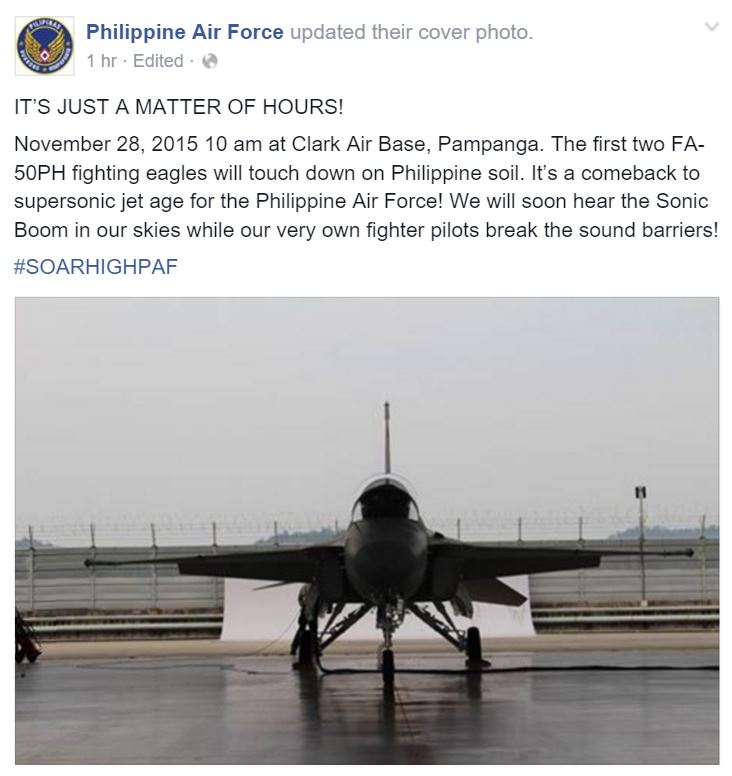 |
Korean Aerospace posted pictures of the take off sequence here.
For updates on the progress of the aircraft, see the following thread on Timawa.net. Note that this Timawa thread will eventually be merged with the original SAA/LIFT thread, so the first link will eventually be deactivated.
Strategic Sealift Vessel (SSV) No.2 coming together
Monday , 5, October 2015 Philippine Navy, SSV Leave a commentThe two largest warships in Philippine Navy history are currently under construction at the PT PAL shipyard in Indonesia. The first vessel, tentatively named “Strategic Sealift Vessel (SSV) No.1”, is due for delivery in May 2016. Progress of construction for that vessel is chronicled in the following article: Strategic Sealift Vessel No. 1 taking shape. This article, on the other hand, chronicles the progress of SSV No.2, whose construction lags behind SSV No.1 by six months.
Both vessels are based on the Indonesian Navy’s Makassar class Landing Ship Dock (LPD), particularly the last two members of the class referred to as the “improved Makassar”, which were both built at PT PAL, based on a design by Daesun Shipbuilding & Engineering of South Korea. The resulting vessel should appear similar to the KRI Banda Aceh shown below.
 |
| KRI Banda Aceh c/o Wikimedia |
The data assembled below largely comes from open-sources and is thanks in no small part to Indonesian members of the Timawa.net forum who monitor Indonesian news reports and share them with the Timawa community. Supplemental data was gleaned from the international press.
| Event / Date photo was shared | Imagery | ||||||||||
| January 8, 2016. TR4 block of SSV-2 being moved into position. | 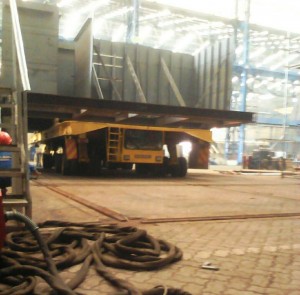 |
||||||||||
| December 22, 2015. Blocks prepared for keel laying | 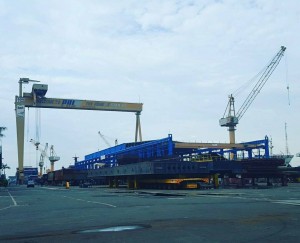 |
||||||||||
| October 25, 2015. Hull block completed. Shared on the Timawa FB extension | 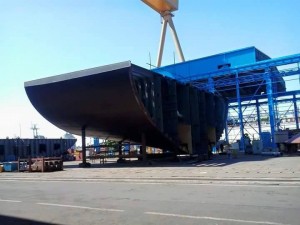 |
||||||||||
| October 5, 2015. Various photographs of keel construction. Shared with the Timawa community’s FB extension on this date. See here |
|
||||||||||
| June 5, 2015. Steel cutting ceremony for SSV-2 held at PT PAL Indonesia. Photo c/o Tribunnews.com |
|
The Strategic Sealift Vessel project is the Aquino administration’s implementation of two older Arroyo administration projects:
Strategic Sealift Vessel – this was reportedly crafted by the Center for Naval Leadership and Excellence (CNLE) and originally envisioned to acquire a 2nd-hand civilian Roll-On Roll-Off (RORO) vessel from Japan. Delays in the execution of the project resulted in an aborted attempt as the Japanese vendor choose to sell the prospective vessel to another buyer.
Multi-Role Vessel (MRV) – this project sought to acquire a brand-new Makasaar class Landing Ship Dock directly from South Korea complete with an amphibious assault package and a sophisticated mobile hospital. The following image of a Philippine Navy poster displayed on Navy Day shows what this project sought to acquire as a single project.
 |
| The original project that was broken up onto different components |
The current administration opted to break up the MRV project into multiple components, award the contract to South Korea’s partner in Indonesia — which had the license rights to the Makassar class LPD — and then renamed the project to the current SSV title. The latter decision initially created confusion among long-time defense enthusiasts who had been aware of both projects, but were not privy to project decisions.
Discussions about the two SSVs are available on the Timawa.net forum at the following locations:
Manilaliveware: From parody to plagiarism
Wednesday , 30, September 2015 About this blog Leave a commentUpdate: Within 12 hours of complaints by multiple Timawans on Manilalivewire’s Facebook (FB) page, Manilalivewire quietly — with no admission of wrongdoing — adjusted their article. See here.
Many thanks to the forum members who lent their voice to the protest. It is unfortunate that the mere act of calling attention to their malfeasance got you banned from their FB page.
Details of adjustments made are available at the bottom of this article.
What was plagiarized?
Compare the Manilalivewire article captured below with the following adroth.ph article. The parody site’s entry, dated September 28, is a word-for-word copy of this blog’s article dated September the 26. Right down to the acknowledgement of “Indonesian Timawans” — but without the context for what a Timawan was. A “Timawan” in the original article’s context referred to the members of the Timawa.net forum.
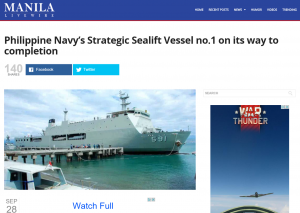 |
 |
 |
The post-complaint modifications to the Manilalivewire article include:
- Removal of references to “Indonesian Timawans” and replacement with “Indonesian media and Wikipedia”. Which by itself still ignores the work put in by Indonesian Timawans who monitored Indonesian media to bring the photos, used in both this and the Manilalivewire article, into focus
- Removal of references to SSV-1 being the largest combat vessel in Philippine Navy history, and comparisons to BRP Mactan
- Removal of references to the “improved Makasaar design”, and even references to original designer: Daesun Shipbuilding & Engineering of South Korea
The word-by-word copy of the descriptions of the photographs remain however.
Strategic Sealift Vessel No. 1 taking shape
Saturday , 26, September 2015 Philippine Navy, SSV 2 CommentsUpdate: SSV-1 now named “BRP Tarlac (LD-601)” and launched.
====
The largest combat ship in Philippine Navy history is well on its way to completion. The still un-named Strategic Sealift Vessel (SSV) No.1 is reportedly due to be launched next year, and as revealed during the 80th anniversary of the Armed Forces of the Philippines, delivery is expected in March 2016. The SSV is based on the Indonesian Navy’s improved Makassar class Landing Ship Dock (LPD) shown below, and is being built by PT PAL in Indonesia from a design by Daesun Shipbuilding & Engineering of South Korea.
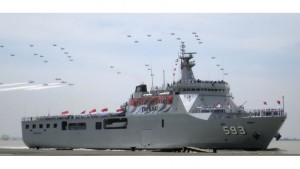 |
| Photo of KRI Banda Aceh c/o IHS Jane’s |
Based on technical specifications for the Philippine Navy version of this design have been made public (see here), this variant of the class has expanded spaces for command and control systems, which allows it to function as a flagship, and incorporates semi-stealth technology. It has a displacement of 7,3000 tons, and is 120 meters long, which is twenty-two meters longer than the previous Philippine Navy record holder: the 103-meter supply ship BRP Mactan. The ship has maximum speed of 16 knots, with a cruising speed of 13 knots. Based on insights gleaned from its Indonesian sisterships it has a range of 10,000 miles, and can remain at sea for 30 days. It is equipped with a bow thruster for, among other things, autonomous in-port maneuverability.
This article chronicles the progress of construction. The data assembled below largely comes from open-sources and is thanks in no small part to Indonesian Timawans who monitor Indonesian news reports and share them with the Timawa community. Supplemental data was gleaned from the international press.
| Event / Date photo was shared | Imagery | |||||||
| January 19, 2016. After the PT PAL spillway had completely flooded, the BRP Tarlac was floated out and brought along side an adjacent pier where work continued on its internal spaces. Photograph c/o Gombaljaya on the Timawa FB extension. |  |
|||||||
| January 18, 2016. Launching ceremony for SSV-1, now christened “BRP Tarlac (LD-601)”. Photographs c/o the Philippine Navy and ship details c/o PNA article |
|
|||||||
| January 17, 2016. Sporting buntings for the launching ceremony |
|
|||||||
| January 16, 2016. More hull details Photo shared on Timawa FB honeypot by Alberth Minas and the main Timawa forum by Tonnyc@TMW. |
|
|||||||
| January 15, 2016. Hull number revealed: “601” Photo shared on Timawa FB honeypot by Alberth Minas | 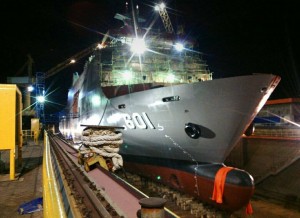 |
|||||||
| January 12, 2016. Painting in progress. Photo c/o Alberth Minas on Timawa FB honeypot. | 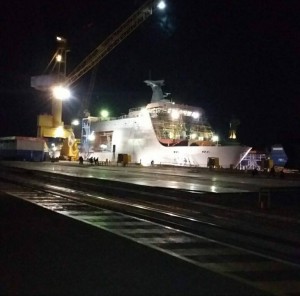 |
|||||||
| January 6, 2016. Propellers are now being installed. Shared on Alberth Minas on the Timawa FB honeypot here. Photo clearly shows that the propeller was manufactured by MAN | 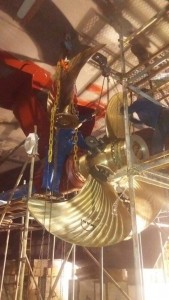 |
|||||||
| December 20, 2015. View of the ship in the slipway. Shared on Timawa by Pudge@timawa. The photo was originally posted on Forum Sejarah & Militer | 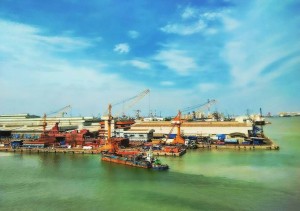 |
|||||||
| November 27, 2015. Mast, and bow mated with the rest of the hull. Vessel outline as an improved Makassar class is now clearly visible. Photo shared on the Timawa FB extension, originally shared on Kaskus forum Indonesia. |
|
|||||||
| November 27, 2015. View of the well deck, helideck, and entrance to the hangar. While the photograph was shared on the Timawa FB extension on the 27th, the contributor, Alberth Minas reported that the photograph had been taken two weeks prior. | 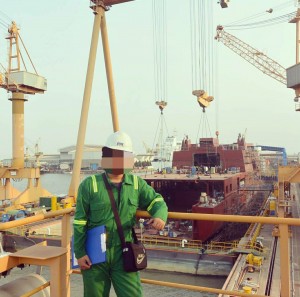 |
|||||||
| November 18, 2015. Port-side hull details. Shared on the main Timawa forum here by madokafc@timawa. | 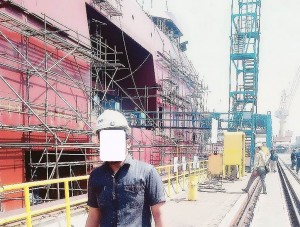 |
|||||||
| November 15, 2015. Closer photo of bulbus bow, attached to the rest of the hull, in the PT PAL drydock. Shared on the main Timawa forum here by firdausj@timawa. | 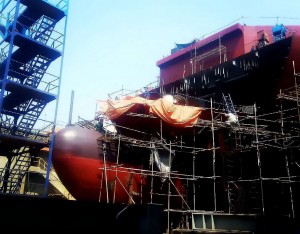 |
|||||||
| October 25, 2015. Main mast under construction. Shared on Timawa FB extension. |  |
|||||||
| October 8, 2015. The well deck where Landing Craft Utilities (LCU) and amphibious craft embark and disembark from the ship. Shared on Timawa FB extension. | 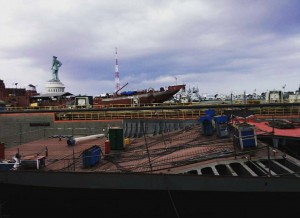 |
|||||||
| October 6, 2015. SSV-1 on slipway. Shared on Timawa FB extension. | 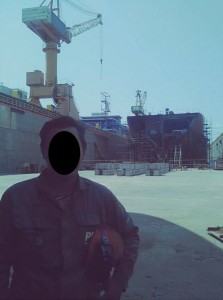 |
|||||||
| October 4, 2015. Bulbous bow attached to forward segment. Shared on Timawa FB extension. | 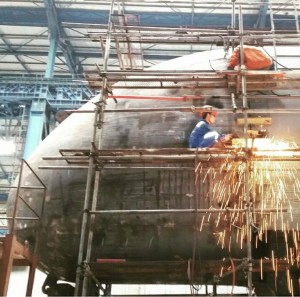 |
|||||||
| September 23, 2015. Attachment point for bulbous bow assembled. Shared on Timawa FB extension. | 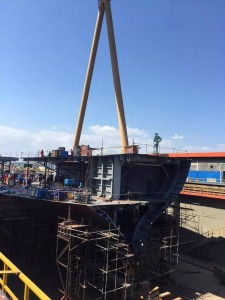 |
|||||||
| August 24, 2015. ASF-1F block completed, being lifted in place. Shared on Timawa FB extension |  |
|||||||
| August 14, 2015. Engines being installed. Photos c/o aktual.com |
|
|||||||
| July 30, 2015. Bulbous bow section completed |  |
|||||||
| June 5, 2015. Assembly of completed keel components. Tribun news photos shared on the Timawa FB extension | 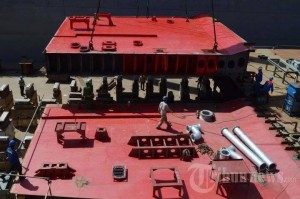 |
|||||||
| May 13, 2015. Keel construction underway | 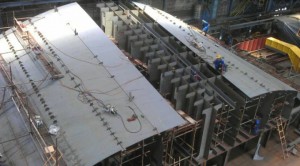 |
|||||||
| January 22, 2015. Steel cutting ceremony for SSV-1 held at PT PAL Indonesia | 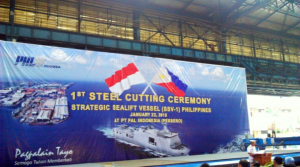 |
The Strategic Sealift Vessel project is the Aquino administration’s implementation of two older Arroyo administration projects:
Strategic Sealift Vessel – this was reportedly crafted by the Center for Naval Leadership and Excellence (CNLE) and originally envisioned to acquire a 2nd-hand civilian Roll-On Roll-Off (RORO) vessel from Japan. Delays in the execution of the project resulted in an aborted attempt as the Japanese vendor choose to sell the prospective vessel to another buyer.
Multi-Role Vessel (MRV) – this project sought to acquire a brand-new Makassar class Landing Ship Dock directly from South Korea complete with an amphibious assault package and a sophisticated mobile hospital. The following image of a Philippine Navy poster displayed on Navy Day shows what this project sought to acquire as a single project.
 |
| The original project that was broken up onto different components |
The current administration opted to break up the MRV project into multiple components, award the contract to South Korea’s partner in Indonesia — which had the license rights to the Makasaar class LPD — and then renamed the project to the current SSV title. The latter decision initially created confusion among long-time defense enthusiasts who had been aware of both projects, but were not privy to project decisions.
Discussions about the two SSVs are available on the Timawa.net forum at the following locations:
Landing Craft Utilities (LCU) of the Philippine Navy
Monday , 10, August 2015 LCU Mk.6, Philippine Navy Leave a commentLanding Craft Utilities (LCU) are ships designed to transport troops and material to shore without the need for piers and similar facilities. Smaller than ocean-going Landing Ship Tanks (LST), these vessels are currently used for inter-island transport of AFP maneuver units as well as for disaster relief operations. In conventional amphibious operations, both LSTs and LCUs would be used for administrative landings on established beachheads already captured from an enemy. They are not designed for landings under fire.
 |
| BRP Benguet, when it was still USN LST 692, with Mk.6 LCU #764 embarked. Photo by Joe Weber c/o navsource.org |
The Philippine Navy’s use of the term traces its origins to the landing craft it obtained from the US Navy. The USN originally called these vessels “Landing Craft Tank” during World War II, but reclassified them as LCUs in 1956.
The following table compares the four operational classes of LCUs in the Philippine Navy. Data for all vessels were either taken from Janes Fighting Ships 2014-2015 edition or Combat Fleets of the World 15th Edition. Because of a lack of direct information for the South Korean Mulkae class, the entries and photograph here were extrapolated from the LCU 1610 of the US Navy from which the South Korean boats were copied. Capacity information for the BRP Tagbanua, however, was obtained from members of the now defunct Philippine Navy Modernization Office, which oversaw the acquisition and sea trials of the vessel.
| ex-USN Mk.6 LCU | ex-ROKN Mulkae LCU | ex-RAN LCH | BRP Tagbanua | |||||
 |
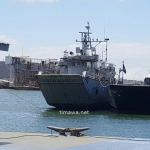 |
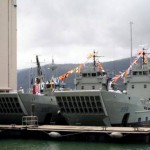 |
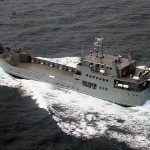 |
|||||
| Displacement, tonnes | 258 full load | 415 full load | 517 full load | 579 full load | ||||
| Dimensions, meters | 36.3 x 9.96 x 1.02 | 41.07 x 9.07 x 2.08 | 44.5 x 10.1 x 2 | 51.4 x 10 x 1.52 | ||||
| Speed, knots | 7 | 11 | 10 | 14 | ||||
| Range, miles | 700 @7kt | 560 @ 11kt | 3,000 @ 10kt | n/a | ||||
| Complement | 12 | 12 | 16 | n/a | ||||
| Military lift | 136 tons | 143 tons | 2 x M1A1 | 200 tons & 200 troops | ||||
| Inventory | BRP Tausug (AT-295) BRP Bagobo (AT-293) BRP Subanon (AT-291) |
Un-named LCU | BRP Ivatan (AT-298) BRP Batak (AT-299) |
BRP Tagbanua (AT-296) |
The bulk of these types of ships in Philippine Navy service consist of second-hand Excess Defense Articles (EDA), obtained from the United States and more recently from Australia and South Korea. Ships from the latter two countries arrived in 2015.
Two LCUs were built locally. One was commissioned into service with all the fan fare befitting a major Philippine manufacturing achievement. The other was quietly accepted under controversial circumstances. This second boat is best discussed in a separate future article, and will be omitted from this discussion.
The oldest ships in the fleet are ex-US Navy Mk.6 LCUs. Three of these World War II-era boats are currently in service: BRP Tausug (AT-295), BRP Bagobo (AT-293), BRP Subanon (AT-291). Though equally old as its sisterships, the BRP Tausug was a relatively new addition to the roster as it was recommissioned from the navy’s strategic reserves in 2009.
On the 30th of May, 2015, a Mulkae class LCU from South Korea, that had been donated to the Philippines in June 2014, arrived at the Cavite Naval Yard where it was slated to be refurbished. The Mulkae — which translates to “fur seal” — is the South Korean version of the US LCU 1610, of which six were built from 1979 to 1981. The Mulkae donated to the Philippines, designated LCU 78, entered South Korean service in 1981. As of writing the ship’s Philippine designation remains unclear.
On the 2nd of July 2015, Philippine Navy personnel arrived in Australia to take possession of two Balikpapan Class Landing Craft Heavy (LCH): HMAS Tarakan and HMAS Brunei. Both ships were commissioned into the Royal Australian Navy in 1973 and will be subject to navigational upgrades before being turned over to the Philippines. While the South Korean LCU’s designation remained unclear even after arrival in the Philippines, the names for the two Australian boats have already been announced, BRP Ivatan (AT-298) and BRP Batak (AT-299), while still overseas.
The first of the two new LCUs in the inventory is the BRP Tagbanua (AT-296). This ship is noteworthy, not only because it is not a hand-me-down, but also because it is a Philippine-built ship. It is currently the largest locally-built ship in the Philippine Navy, displacing the previous record holder: the Aguinaldo class patrol gunboats. AT-296 also remains the largest LCU in the fleet, surpassing the Balikpapaan class in both displacement and physical dimensions.
Another noteworthy differentiator for the Tagbanua was that it was designed specifically with the Philippine Navy’s intended use for these vessels in mind: inter-island movement of troops and equipment. For this reason, it can transport 200 troops within a passenger compartment, protected from the elements, in addition to carrying 200 tons or cargo.
Growing the force
In 2012, the Philippine Navy published what it called its Desired Force Mix. The mix laid out what the navy perceived as the minimum number of ships it required for various roles. The list identified a need for 18 Landing Craft Utilities. With only six LCUs either in service or due to enter service, there is a significant gap in amphibious capability. With that gap, however, comes opportunity for the Philippine shipbuilding industry.
When the tandem of Propmech and Philippine Iron Construction & Marine Works (PICMW) turned over the BRP Tagbanua to the Philippine Navy in November 2011, they not only proved that the local shipyards could meet military needs, they also demonstrated how widespread qualified shipyards in the country really are. This shipyard isn’t based in any of the usual suspects: Subic Bay, Balamban, Cebu or Batangas which often draw attention for their hosting foreign owned shipyards like Hanjin, Keppel, and Tsuneishi. PICMW calls Jasaan, Misamis Oriental home. This achievement shows that if the invitation to bid is made, industry players across the nation can respond with indigenous designs optimized for the AFP’s needs.
The acquisition project that eventually acquired the BRP Tagbanua had an Authorized Budget for Contract of approximately P190M. That translates to P2.85B worth of construction contracts that could potentially go to local shipyards if all 15 additional LCUs are sourced locally. Domestic manufacture, however, will always be hampered by one key consideration: “Time to deploy”.
Buying more EDA ships, like the Mulkae and Balikpapan class, would grow the LCU force faster. Especially when these assets are acquired in the form of a “hot transfer”, where the ship to be transferred is never actually decommissioned and simply changes crews. But this mode of acquisition not only deprives local shipyards of manufacturing opportunities, the resulting potpourri of ships also creates logistical issues by introducing a myriad of non-standard equipment. The existing six LCUs, for example, already involve four different engine types. Each of which will require a logistical trail.
Fifteen new locally-built LCUs following a single design would mean standardized equipment, and consequently simplify logistics. However, given how long it took the Tagbanua project to bear fruit, the DND-AFP would need to balance its need to fill the gap as-soon-as-possible, with other concerns to include its goal of supporting local manufacturing industries as part of the Self-Reliant Defense Posture (SRDP) program.
Arguably, the way forward for meeting the goals of the Desired Fleet Mix will require a combination of quick EDA acquisitions balanced with domestic production. The key will be in finding that balance, and designating a specific number that the domestic industry must be tasked — or challenged — to satisfy.
Discussion:
To discuss this article visit its companion thread on the Timawa.net forum here
Sources:
Janes Fighting Ships 2014 – 2015
US Amphibious Ships and Craft
Combat Fleets of the World, 15th Edition
http://www.naval-technology.com/projects/balikpapanclasslch/
http://www.naval-technology.com/news/newsphilippine-navy-to-receive-two-decommissioned-lch-vessels-from-australia-4532795
http://www.zambotimes.com/archives/news/91808-Australian-donated-LCHs-to-be-commissioned-on-July-23.html
http://ww2lct.org/mk6/mk6main.htm
http://www.navsource.org/archives/10/18/18idx.htm
